Creating engaging blog posts is essential for capturing attention and maintaining reader interest. By employing storytelling, visuals, and interactive elements, you can effectively connect with your audience. Additionally, choosing the right format, such as listicles or tutorials, can enhance interaction and retention, while strategies like social media engagement and consistent communication foster a vibrant community around your content.
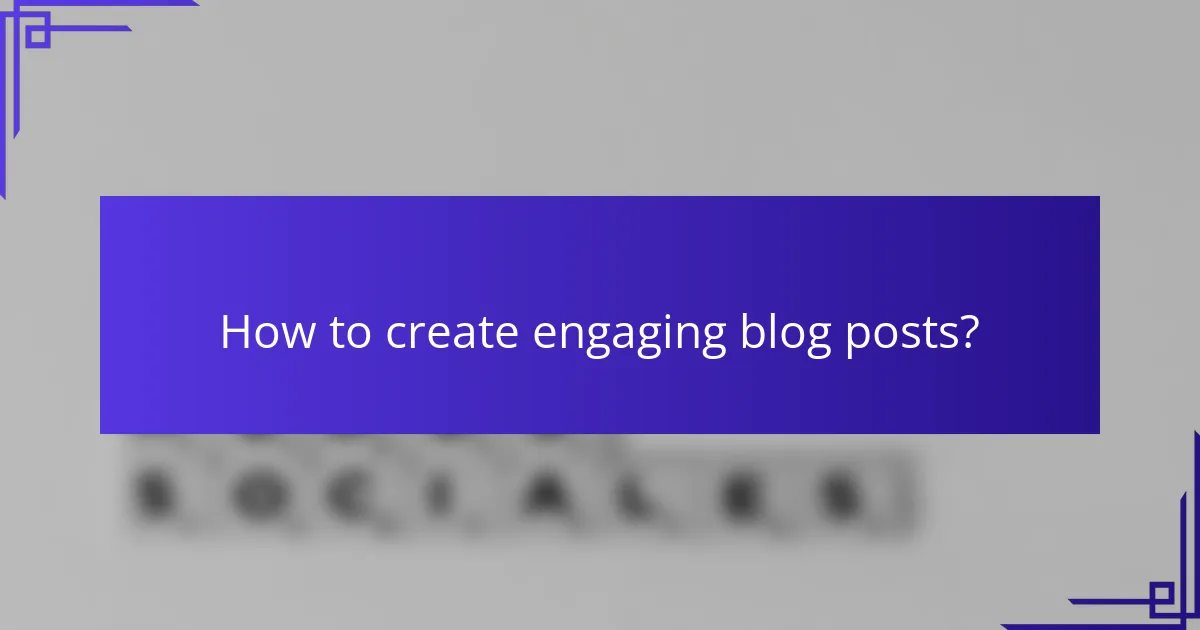
How to create engaging blog posts?
Creating engaging blog posts involves using techniques that capture attention and maintain interest. Focus on storytelling, visuals, and interactivity to connect with your audience effectively.
Use storytelling techniques
Storytelling techniques can transform a standard blog post into a captivating narrative. Start with a relatable character or scenario that resonates with your readers, drawing them into the story.
Incorporate elements like conflict and resolution to create tension and keep readers invested. For example, share a personal experience or a case study that illustrates a challenge and how it was overcome.
Incorporate visuals and multimedia
Visuals and multimedia enhance engagement by breaking up text and providing alternative ways to consume information. Use images, infographics, and videos to complement your written content and illustrate key points.
Consider the context of your audience; for instance, a blog targeting tech enthusiasts might benefit from detailed diagrams or product demos. Aim for high-quality visuals that align with your brand’s aesthetic.
Utilize interactive elements
Interactive elements invite readers to engage actively with your content, increasing retention and enjoyment. Incorporate quizzes, polls, or comment sections to encourage participation and feedback.
For example, a blog about travel could include a poll asking readers about their favorite destinations, fostering a sense of community. Ensure that these elements are easy to use and relevant to the topic at hand.
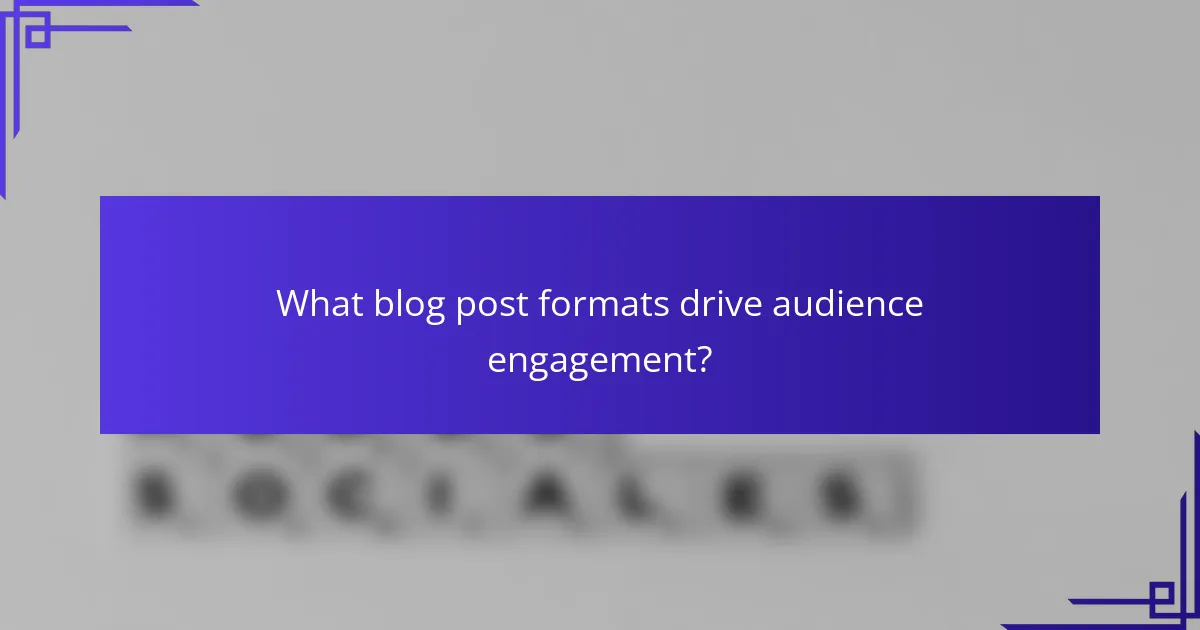
What blog post formats drive audience engagement?
Engaging blog post formats include listicles, tutorials, and interviews, each catering to different reader preferences and needs. Selecting the right format can significantly enhance audience interaction and retention.
Listicles for quick consumption
Listicles are structured articles that present information in a numbered or bulleted format, making them easy to skim. They appeal to readers looking for quick insights or tips, often leading to higher engagement rates.
To create an effective listicle, focus on a specific theme and keep each item concise. For example, a list titled “5 Essential Tools for Remote Work” can provide brief descriptions and links to resources, making it practical and actionable.
When writing listicles, avoid overwhelming readers with too many points; aim for a range of five to ten items to maintain clarity and interest.
Tutorials for practical guidance
Tutorials offer step-by-step instructions on how to accomplish a specific task, making them valuable for readers seeking practical knowledge. This format encourages deeper engagement as readers often follow along with the content.
When crafting a tutorial, break down the process into manageable steps and use clear language. For instance, a tutorial on “How to Set Up a Blog in 10 Minutes” can guide users through the necessary actions with screenshots or examples.
Ensure to include common pitfalls and troubleshooting tips to enhance the reader’s experience and prevent frustration during the learning process.
Interviews with industry experts
Interviews provide unique insights by featuring conversations with industry experts, adding credibility and depth to your content. This format not only engages readers but also positions your blog as a trusted source of information.
To conduct an effective interview, prepare thoughtful questions that elicit detailed responses. For example, asking an expert about “Emerging Trends in Digital Marketing” can yield valuable perspectives that resonate with your audience.
Promote the interview through social media and relevant channels to maximize reach, and consider including quotes or highlights to draw in readers who may skim the content.
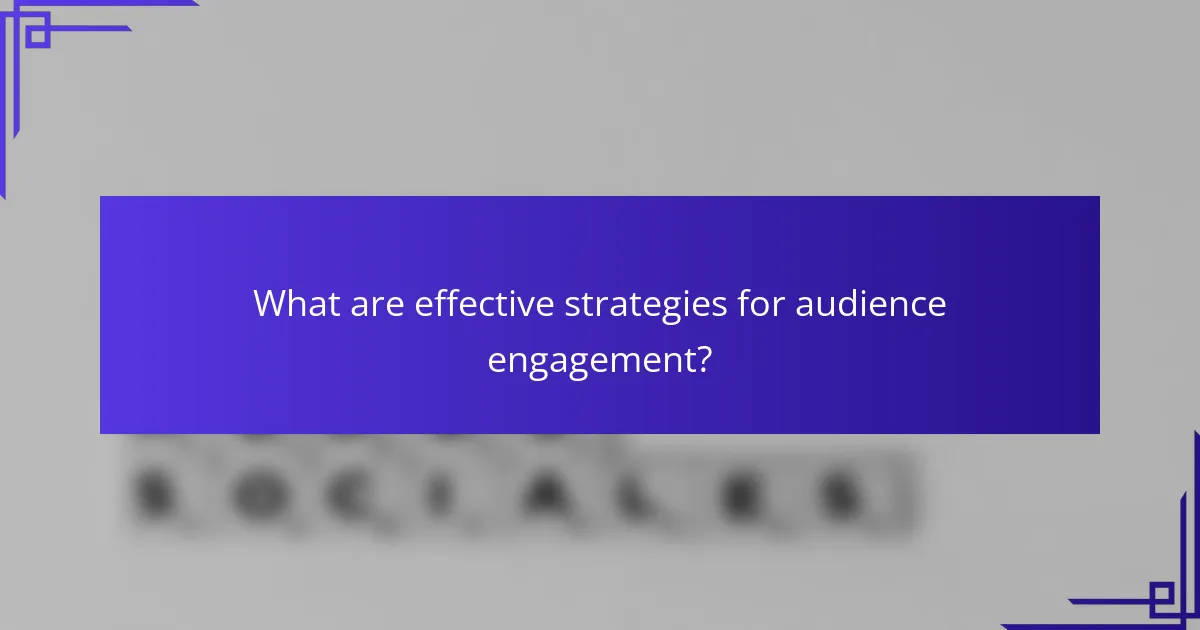
What are effective strategies for audience engagement?
Effective strategies for audience engagement include fostering interaction, utilizing social media, and maintaining consistent communication through email. These methods help build a community around your content and encourage ongoing participation.
Encourage comments and discussions
Inviting readers to leave comments and engage in discussions can significantly enhance audience interaction. Pose open-ended questions at the end of your posts to stimulate conversation and encourage diverse viewpoints.
Moderate the comments section to maintain a respectful environment, responding to readers to show appreciation for their input. This interaction can lead to a loyal audience that feels valued and connected to your content.
Leverage social media sharing
Social media platforms are powerful tools for audience engagement. Share your blog posts across various channels like Facebook, Twitter, and Instagram to reach a broader audience and encourage shares from your followers.
Incorporate social sharing buttons on your blog to make it easy for readers to share content. Consider creating visually appealing graphics or snippets that can be shared to grab attention and drive traffic back to your site.
Implement email newsletters
Email newsletters are an effective way to keep your audience informed and engaged. Regularly send out updates featuring your latest blog posts, exclusive content, or special offers to encourage readers to return to your site.
Segment your email list based on interests or behaviors to tailor content to specific groups. This personalization can increase open rates and engagement, making your newsletters a valuable tool for maintaining audience interest.

How to measure the success of blog posts?
Measuring the success of blog posts involves evaluating various metrics that reflect reader engagement and conversion. Key indicators include engagement metrics, reader feedback, and conversion rates, which together provide a comprehensive view of a post’s performance.
Track engagement metrics
Engagement metrics are essential for understanding how readers interact with your blog posts. Key metrics to track include page views, average time on page, bounce rate, and social shares. Tools like Google Analytics can help you gather this data effectively.
For instance, a high page view count combined with a low average time on page may indicate that while many readers are clicking through, they are not finding the content engaging. Aim for an average time on page that reflects meaningful interaction, typically in the range of 2-5 minutes for blog posts.
Analyze reader feedback
Reader feedback provides qualitative insights into how your audience perceives your content. This can be gathered through comments, surveys, or direct messages. Encourage readers to share their thoughts and suggestions to foster a sense of community and improve future posts.
Consider implementing a simple feedback form at the end of each post, asking readers to rate the content and provide any comments. This can help identify common themes and areas for improvement, ensuring your content remains relevant and engaging.
Monitor conversion rates
Conversion rates measure how effectively your blog posts drive desired actions, such as newsletter sign-ups, product purchases, or downloads. To assess this, track the number of conversions relative to the total visitors to your blog post.
For example, if a blog post receives 1,000 views and generates 50 sign-ups, the conversion rate is 5%. Aim for a conversion rate that aligns with industry standards, which can vary but often fall between 1-5%. Regularly analyze these rates to optimize your content strategy and improve performance.
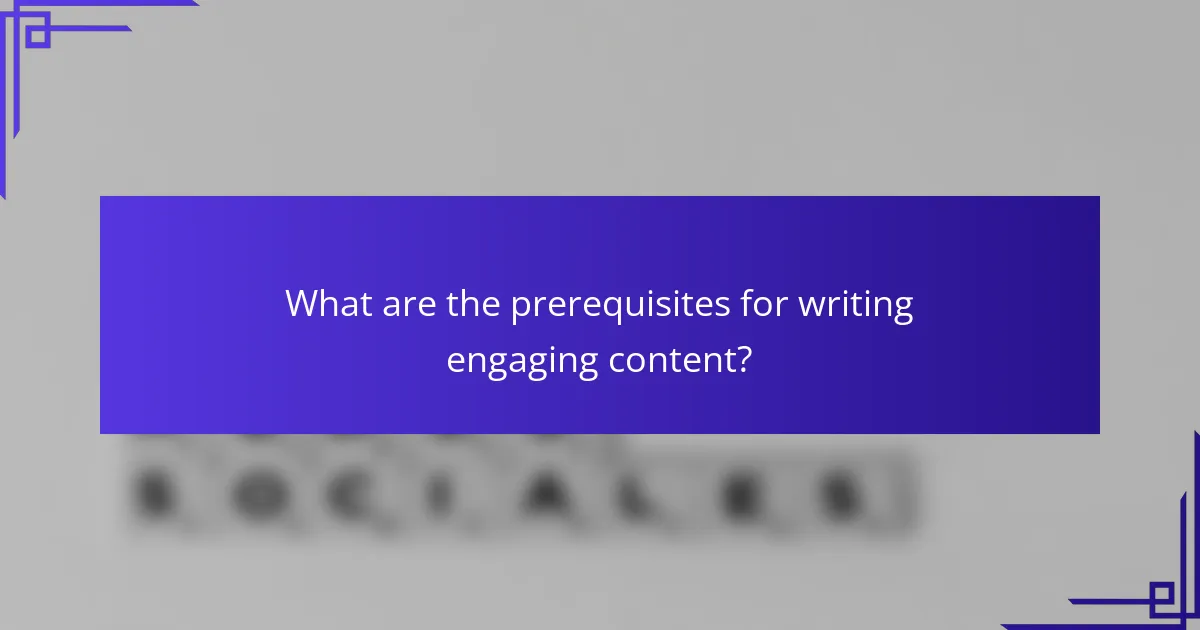
What are the prerequisites for writing engaging content?
To write engaging content, you need a clear understanding of your audience, effective keyword research, and a well-structured content calendar. These elements ensure that your writing resonates with readers and meets their needs while optimizing for search engines.
Understand your target audience
Knowing your target audience is crucial for creating engaging content. Start by defining demographics such as age, gender, location, and interests. This information helps tailor your writing style, tone, and topics to what resonates most with your readers.
Consider creating audience personas to visualize your ideal readers. These personas should include their goals, challenges, and preferences, which will guide your content creation process. Engaging content speaks directly to the audience’s needs and desires.
Conduct keyword research
Keyword research is essential for ensuring your content reaches the right audience. Use tools like Google Keyword Planner or SEMrush to identify relevant keywords that your audience is searching for. Focus on a mix of short-tail and long-tail keywords to capture various search intents.
Incorporate these keywords naturally into your content, including headings and subheadings, to improve search engine visibility. Avoid keyword stuffing, as it can detract from the quality of your writing and negatively impact user experience.
Establish a content calendar
A content calendar helps you plan and organize your writing efforts effectively. It allows you to schedule topics, deadlines, and publication dates, ensuring a consistent flow of content. This consistency is key to keeping your audience engaged over time.
When creating your calendar, consider seasonal trends and relevant events that may impact your audience’s interests. Aim for a mix of content types, such as blog posts, infographics, and videos, to maintain variety and appeal to different preferences.
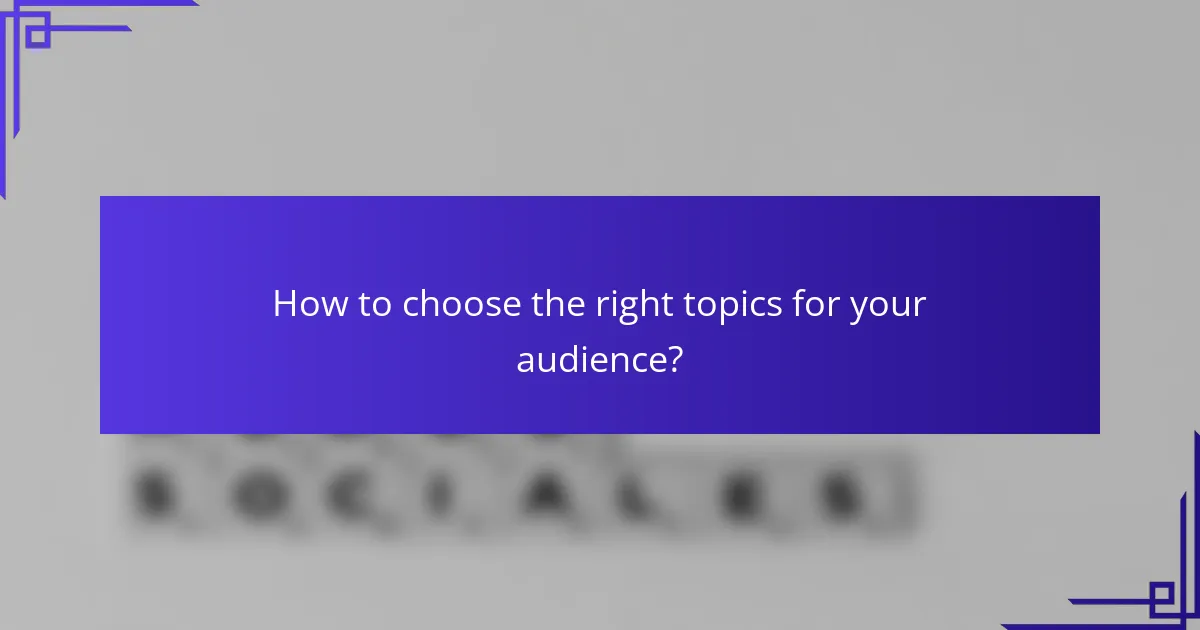
How to choose the right topics for your audience?
Selecting the right topics for your audience involves understanding their interests and needs. Focus on relevance and engagement to ensure your content resonates and encourages interaction.
Identify trending subjects in your niche
To find trending subjects, monitor industry news, social media, and popular blogs within your niche. Tools like Google Trends or BuzzSumo can help identify what topics are currently capturing attention.
Consider creating content around these trends, as they often reflect the immediate interests of your audience. For instance, if sustainability is trending, articles on eco-friendly practices can attract readers.
Utilize audience surveys for feedback
Conducting audience surveys is an effective way to gather direct feedback on what topics your readers want to explore. Use platforms like SurveyMonkey or Google Forms to create simple questionnaires.
Ask specific questions about their interests and preferences, and analyze the results to inform your content strategy. This approach not only helps in topic selection but also fosters a sense of community and engagement with your audience.
